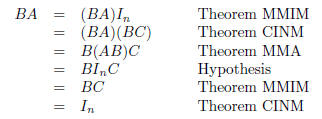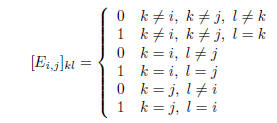- Home
- INTERMEDIATE ALGEBRA
- Course Syllabus for Algebra I
- Mid-Plains Community College
- FRACTION OF A WHOLE NUMBER
- Systems of Linear Equations
- MATH FIELD DAY
- Course Outline for Finite Mathematics
- Calculus
- Algebra Final Examination
- Math 310 Exam #2
- Review of Trigonometric Functions
- Math 118 Practice test
- Precalculus Review
- Section 12
- Literal Equations
- Calculus Term Definitions
- Math 327A Exercise 2
- Public Key Algorithms II
- Maximizing Triangle Area
- Precalculus I Review for Midterm
- REVIEW OF A FIRST COURSE IN LINEAR ALGEBRA
- Math 6310 Homework 5
- Some Proofs of the Existence of Irrational Numbers
- ALGEBRAIC PROPERTIES OF MATRIX OPERATIONS
- Math 142 - Chapter 2 Lecture Notes
- Math 112 syllabus
- Math 371 Problem Set
- Complex Numbers,Complex Functions and Contour Integrals
- APPLICATIONS OF LINEAR EQUATIONS
- Week 4 Math
- Fractions
- Investigating Liner Equations Using Graphing Calculator
- MATH 23 FINAL EXAM REVIEW
- Algebra 1
- PYTHAGOREAN THEOREM AND DISTANCE FORMULA
- Georgia Performance Standards Framework for Mathematics - Grade 6
- Intermediate Algebra
- Introduction to Fractions
- FACTORINGS OF QUADRATIC FUNCTIONS
- Elementary Algebra Syllabus
- Description of Mathematics
- Integration Review Solutions
- College Algebra - Applications
- A Tip Sheet on GREATEST COMMON FACTOR
- Syllabus for Elementary Algebra
- College Algebra II and Analytic Geometry
- Functions
- BASIC MATHEMATICS
- Quadratic Equations
- Language Arts, Math, Science, Social Studies, Char
- Fractions and Decimals
- ON SOLUTIONS OF LINEAR EQUATIONS
- Math 35 Practice Final
- Solving Equations
- Introduction to Symbolic Computation
- Course Syllabus for Math 935
- Fractions
- Fabulous Fractions
- Archimedean Property and Distribution of Q in R
- Algebra for Calculus
- Math112 Practice Test #2
- College Algebra and Trigonometry
- ALGEBRA 1A TASKS
- Description of Mathematics
- Simplifying Expressions
- Imaginary and Complex Numbers
- Building and Teaching a Math Enhancement
- Math Problems
- Algebra of Matrices Systems of Linear Equations
- Survey of Algebra
- Approximation of irrational numbers
- More about Quadratic Functions
- Long Division
- Algebraic Properties of Matrix Operation
- MATH 101 Intermediate Algebra
- Rational Number Project
- Departmental Syllabus for Finite Mathematics
- WRITTEN HOMEWORK ASSIGNMENT
- Description of Mathematics
- Rationalize Denominators
- Math Proficiency Placement Exam
- linear Equations
- Description of Mathematics & Statistics
- Systems of Linear Equations
- Algebraic Thinking
- Study Sheets - Decimals
- An Overview of Babylonian Mathematics
- Mathematics 115 - College Algebra
- Complex Numbers,Complex Functions and Contour Integrals
- Growing Circles
- Algebra II Course Curriculum
- The Natural Logarithmic Function: Integration
- Rational Expressions
- QUANTITATIVE METHODS
- Basic Facts about Rational Funct
- Statistics
- MAT 1033 FINAL WORKSHOP REVIEW
- Measurements Significant figures
- Pre-Calculus 1
- Compositions and Inverses of Functions
REVIEW OF A FIRST COURSE IN LINEAR ALGEBRA
DAVID S. WATKINS
As textbook prices head into the stratosphere, it is
gratifying to observe that
some people are trying to do something about it. Robert Beezer has made his text
A
First Course in Linear Algebra available to the public for free. A MathML
hypertext
version is on the web at , you can download a pdf version, or
you can buy an inexpensive paper copy through the print-on-demand service
lulu.com.
The online and pdf versions contain links back to all theorems, definitions,
etc., as
they are used.
This book is a work in progress. There are three parts:
Core, Topics, and Applications,
but only the Core part resembles a finished book. The other two are just
beginning to take form. The author envisions adding more and more to the book
over
time, and he encourages all of us to help out by making contributions. To this
end he
has made the TEX source code available. Users of the book are free to modify it
and
share their modifications with others, subject to the terms of the GNU Free
Document
License. As the author notes in the preface, “[This book] will never go ‘out of
print’
nor will there ever be trivial updates designed to frustrate the used book
market.”
So what is the book like? First of all, all chapters,
sections, theorems, and other
items are given acronyms instead of numbers. Some examples: The chapter on
vector
spaces is Chapter VS. A theorem that says that linear transformations take zero
to
zero is called Theorem LTTZZ. The section on injective linear transformations is
Section ILT. This practice has the advantage that Theorem LTTZZ will always have
that name, even as the book changes shape over time. The disadvantage is that
the
text is cluttered with acronyms, most of which will have no immediate meaning
for
the reader.
The focus of the book is theoretical. Quoting again from
the preface: “This
textbook is designed to teach the university mathematics student the basics of
the
subject of linear algebra and the techniques of formal mathematics.” Thus the
book
is meant for mathematics majors, and proofs and proof techniques are emphasized.
The tone of the book is mostly formal; equations are preferred over words. Most
of the proofs contain long chains of equalities like this one taken from the
proof of
Theorem OSIS (one side is sufficient), which shows that a right inverse is also
a left
inverse:

In the electronic versions, the cited theorems have links
back to their statements. In
the paper version, page numbers are given.
This is a text for an algebra course. As the author states
in the very first section,
“. . .we will maintain an algebraic approach to the subject, with the geometry
being
secondary. . . . here and now we are laying our bias bare.” Indeed, the book is
entirely
algebraic; geometry is nowhere to be found.
The book begins concretely. There is a chapter on solving
linear systems using
row-echelon form. This is followed by a chapter on vectors in Cn that introduces
concepts such as linear combinations, linear independence, spanning sets, and
orthogonality.
Then a chapter on matrices introduces matrix operations, the matrix inverse,
null space, row space, column space, and the like. The relationships between
these
concepts and the solution of linear systems are laid out. After this the book
takes an
abstract turn, with chapters on vector spaces and linear transformations.
Sandwiched
between these are chapters on determinants and eigenvalues of matrices. This
ordering
strikes me as odd, but perhaps the order is not so important. The final chapter
of
the Core part of the book is on representations of linear transformations by
matrices,
culminating in the Jordan canonical form.
In my paper copy of the book, the Topics and Applications
parts are empty. On
the web there are, as of this writing, a couple of sections in Applications and
ten
or so in Topics. The author’s intent is that the Topics part will include topics
that
the author deems not to be part of the core but that some instructors might like
to
include in their courses. For example, the fact that Gaussian elimination yields
an
LU decomposition of a matrix is included in Topics and not mentioned in the
Core.
This choice reminds us once again of the bias of the book.
This is definitely a
“pure math” treatment of linear algebra. It is assumed that all arithmetic can
be done
exactly. Nowhere is it mentioned that the principal algorithms presented in the
Core
break down when executed in floating-point arithmetic on a computer or
calculator.
(For example, row reduction cannot determine reliably whether a square matrix is
singular or not.) Condition numbers are not mentioned, nor are the superior
numerical
properties of unitary transformations. The Gram-Schmidt process is introduced in
the
core, but the QR decomposition is not mentioned at all. (Hopefully it will at
least be
added as a topic later.) The singular value decomposition is included as a mere
topic.
We are told that it is useful, but no specific uses (e.g. reliable rank
determination)
are given. Of course, all of this can be changed in the future.
Here’s one other thing I would change: The index is way
too long for a single web
page. It ought to be split over many pages, perhaps 26 or so.
The preference for symbols over words sometimes has bad
consequences. For
example, at the beginning of Chapter D (determinants) a square matrix
 is defined
is defined
as follows:

Got that? Here’s what I would have preferred: “ is the matrix obtained by
is the matrix obtained by
interchanging the ith and jth rows of the identity matrix.”
I was amused by Example CVS (crazy vector space). This is
the set of all ordered
pairs of complex numbers with the operations
(x1, x2) + (y1, y2) = (x1 + y1 + 1, x2 + y2 + 1)
α(x1, x2) = ( αx1 + α − 1, αx2 + α − 1).
This really is a vector space! (What is the “zero”
element?) It is a wonderful example
in the spirit of abstract algebra, but there is no way I would show it to my
sophomores.
I want to develop their intuition, not crush it.
Would I use this book in my course? For me the
total omission of geometry
disqualifies it immediately. A first course in linear algebra ought to contain
lots of
geometry and pictures (along with the algebra) to help those sophomores develop
some insight. Moreover, at my institution the first linear algebra course is
populated
mainly by engineering and science majors. They need to get the basics; they do
not
need an introduction to formal mathematics. That is left for other courses,
including
the second linear algebra course, which is mainly for mathematics majors.
Beezer’s
book would surely be a useful supplemental resource for that course.
Clearly Beezer and I have some philosophical differences
about what ought to be
in a first course in linear algebra. Nevertheless I commend him for undertaking
this
project. Instructors who wish to teach a pure linear algebra course that
emphasizes
rigor and formal mathematics will be able to make good use of this material and
feel
secure in the knowledge that the book is not going to go out of print. Finally,
the
price is right.


